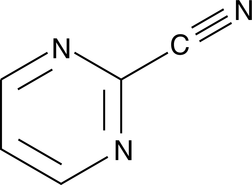Chemicals
Showing 4201–4350 of 41137 results
-
2-BZP (Item No. 24419) is an analytical reference standard categorized as a piperazine. This product is intended for research and forensic applications.
Brand:CaymanSKU:24419 - 5 mgAvailable on backorder
Brand:CaymanSKU:10007123 - 1 gAvailable on backorder
Brand:CaymanSKU:10007123 - 5 gAvailable on backorder
Brand:CaymanSKU:10007123 - 500 mgAvailable on backorder
2-chloro Palmitic acid is a monochlorinated form of palmitic acid (Item No. 10006627). It is produced in a myeloperoxidase (MPO) and time-dependent manner in neutrophils stimulated by phorbol 12-myristate 13-acetate (PMA; Item No. 10008014). 2-chloro Palmitic acid (10 μM) induces neutrophil extracellular trap (NET) formation (NETosis) in human neutrophils, increasing DNA release from neutrophils, colocalization of MPO with extracellular DNA (ecDNA), and trapping of E. coli.{43363} It increases COX-2 protein levels in human coronary artery endothelial cells (HCAECs) when used at a concentration of 50 μM and increases production of P-selectin, von Willebrand factor, and angiopoietin-2 in HCAECs, as well as neutrophil and platelet adherence, when used at a concentration of 10 μM.{43481,43482} 2-chloro Palmitic acid (10-50 μM) also induces apoptosis in THP-1 cells and primary human monocytes and increases caspase-3 activity in THP-1 cells.{43483}
Brand:CaymanSKU:26107 - 1 mgAvailable on backorder
2-chloro Palmitic acid is a monochlorinated form of palmitic acid (Item No. 10006627). It is produced in a myeloperoxidase (MPO) and time-dependent manner in neutrophils stimulated by phorbol 12-myristate 13-acetate (PMA; Item No. 10008014). 2-chloro Palmitic acid (10 μM) induces neutrophil extracellular trap (NET) formation (NETosis) in human neutrophils, increasing DNA release from neutrophils, colocalization of MPO with extracellular DNA (ecDNA), and trapping of E. coli.{43363} It increases COX-2 protein levels in human coronary artery endothelial cells (HCAECs) when used at a concentration of 50 μM and increases production of P-selectin, von Willebrand factor, and angiopoietin-2 in HCAECs, as well as neutrophil and platelet adherence, when used at a concentration of 10 μM.{43481,43482} 2-chloro Palmitic acid (10-50 μM) also induces apoptosis in THP-1 cells and primary human monocytes and increases caspase-3 activity in THP-1 cells.{43483}
Brand:CaymanSKU:26107 - 10 mgAvailable on backorder
2-chloro Palmitic acid is a monochlorinated form of palmitic acid (Item No. 10006627). It is produced in a myeloperoxidase (MPO) and time-dependent manner in neutrophils stimulated by phorbol 12-myristate 13-acetate (PMA; Item No. 10008014). 2-chloro Palmitic acid (10 μM) induces neutrophil extracellular trap (NET) formation (NETosis) in human neutrophils, increasing DNA release from neutrophils, colocalization of MPO with extracellular DNA (ecDNA), and trapping of E. coli.{43363} It increases COX-2 protein levels in human coronary artery endothelial cells (HCAECs) when used at a concentration of 50 μM and increases production of P-selectin, von Willebrand factor, and angiopoietin-2 in HCAECs, as well as neutrophil and platelet adherence, when used at a concentration of 10 μM.{43481,43482} 2-chloro Palmitic acid (10-50 μM) also induces apoptosis in THP-1 cells and primary human monocytes and increases caspase-3 activity in THP-1 cells.{43483}
Brand:CaymanSKU:26107 - 25 mgAvailable on backorder
2-chloro Palmitic acid is a monochlorinated form of palmitic acid (Item No. 10006627). It is produced in a myeloperoxidase (MPO) and time-dependent manner in neutrophils stimulated by phorbol 12-myristate 13-acetate (PMA; Item No. 10008014). 2-chloro Palmitic acid (10 μM) induces neutrophil extracellular trap (NET) formation (NETosis) in human neutrophils, increasing DNA release from neutrophils, colocalization of MPO with extracellular DNA (ecDNA), and trapping of E. coli.{43363} It increases COX-2 protein levels in human coronary artery endothelial cells (HCAECs) when used at a concentration of 50 μM and increases production of P-selectin, von Willebrand factor, and angiopoietin-2 in HCAECs, as well as neutrophil and platelet adherence, when used at a concentration of 10 μM.{43481,43482} 2-chloro Palmitic acid (10-50 μM) also induces apoptosis in THP-1 cells and primary human monocytes and increases caspase-3 activity in THP-1 cells.{43483}
Brand:CaymanSKU:26107 - 5 mgAvailable on backorder
2-chloro Stearic acid is a bioactive fatty acid that accumulates in primary human monocytes and neutrophils as well as murine neutrophils stimulated with phorbol 12-myristate 13-acetate (PMA; Item No. 10008014).{43483,43363} It induces DNA release from primary human neutrophils.{43363} 2-chloro Stearic acid is toxic to C. quinquefasciatus larvae (LC50 = <1 ppm).{36947}
Brand:CaymanSKU:26108 - 1 mgAvailable on backorder
2-chloro Stearic acid is a bioactive fatty acid that accumulates in primary human monocytes and neutrophils as well as murine neutrophils stimulated with phorbol 12-myristate 13-acetate (PMA; Item No. 10008014).{43483,43363} It induces DNA release from primary human neutrophils.{43363} 2-chloro Stearic acid is toxic to C. quinquefasciatus larvae (LC50 = <1 ppm).{36947}
Brand:CaymanSKU:26108 - 10 mgAvailable on backorder
2-chloro Stearic acid is a bioactive fatty acid that accumulates in primary human monocytes and neutrophils as well as murine neutrophils stimulated with phorbol 12-myristate 13-acetate (PMA; Item No. 10008014).{43483,43363} It induces DNA release from primary human neutrophils.{43363} 2-chloro Stearic acid is toxic to C. quinquefasciatus larvae (LC50 = <1 ppm).{36947}
Brand:CaymanSKU:26108 - 25 mgAvailable on backorder
2-chloro Stearic acid is a bioactive fatty acid that accumulates in primary human monocytes and neutrophils as well as murine neutrophils stimulated with phorbol 12-myristate 13-acetate (PMA; Item No. 10008014).{43483,43363} It induces DNA release from primary human neutrophils.{43363} 2-chloro Stearic acid is toxic to C. quinquefasciatus larvae (LC50 = <1 ppm).{36947}
Brand:CaymanSKU:26108 - 5 mgAvailable on backorder
Adenosine receptors are a family of G protein-coupled receptors that display distinct patterns of ligand binding and tissue distribution, regulating a variety of physiological functions. 2-chloro-3-Deazaadenosine is a stable analog of adenosine that acts as an agonist for adenosine receptors (Ki = 0.3, 0.08, 25.5, and 1.9 μM for A1, A2A, A2B, and A3 receptors, respectively).{19450,19451} It can block neurotransmitter release by activating A1 receptors or inhibit neurotransmission by activating A2A receptors.{19446,19453,19448} 2-chloro-3-Deazaadenosine blocks seizures by stimulating A1 receptors.{19449,19452}
Brand:CaymanSKU:9000787 - 1 mgAvailable on backorder
Adenosine receptors are a family of G protein-coupled receptors that display distinct patterns of ligand binding and tissue distribution, regulating a variety of physiological functions. 2-chloro-3-Deazaadenosine is a stable analog of adenosine that acts as an agonist for adenosine receptors (Ki = 0.3, 0.08, 25.5, and 1.9 μM for A1, A2A, A2B, and A3 receptors, respectively).{19450,19451} It can block neurotransmitter release by activating A1 receptors or inhibit neurotransmission by activating A2A receptors.{19446,19453,19448} 2-chloro-3-Deazaadenosine blocks seizures by stimulating A1 receptors.{19449,19452}
Brand:CaymanSKU:9000787 - 10 mgAvailable on backorder
Adenosine receptors are a family of G protein-coupled receptors that display distinct patterns of ligand binding and tissue distribution, regulating a variety of physiological functions. 2-chloro-3-Deazaadenosine is a stable analog of adenosine that acts as an agonist for adenosine receptors (Ki = 0.3, 0.08, 25.5, and 1.9 μM for A1, A2A, A2B, and A3 receptors, respectively).{19450,19451} It can block neurotransmitter release by activating A1 receptors or inhibit neurotransmission by activating A2A receptors.{19446,19453,19448} 2-chloro-3-Deazaadenosine blocks seizures by stimulating A1 receptors.{19449,19452}
Brand:CaymanSKU:9000787 - 5 mgAvailable on backorder
Carbohydrates conjugated with 2-chloro-4-nitrophenyl (CNP) serve as chromogenic substrates in assays for enzymes that release CNP from the conjugated carbohydrate.{27183,27182} For example, CNP-β-D-maltoheptaoside and CNP-α-maltotrioside are chromogenic substrates for α-amylase.{27181,27186} 2-Chloro-4-nitrophenyl-α-D-glucopyranoside is a conjugate of CNP and α-D-glucose. The related conjugate between CNP and β-D-glucose, 2-chloro-4-nitrophenyl β-D-glucopyranoside, is used as a chromogenic substrate for glycosyltransferases.{27185,27184} This product is a chromogenic substrate for enzymes that target the linkage between CNP and α-D-glucose.
Brand:CaymanSKU:-Out of stock
Carbohydrates conjugated with 2-chloro-4-nitrophenyl (CNP) serve as chromogenic substrates in assays for enzymes that release CNP from the conjugated carbohydrate.{27183,27182} For example, CNP-β-D-maltoheptaoside and CNP-α-maltotrioside are chromogenic substrates for α-amylase.{27181,27186} 2-Chloro-4-nitrophenyl-α-D-glucopyranoside is a conjugate of CNP and α-D-glucose. The related conjugate between CNP and β-D-glucose, 2-chloro-4-nitrophenyl β-D-glucopyranoside, is used as a chromogenic substrate for glycosyltransferases.{27185,27184} This product is a chromogenic substrate for enzymes that target the linkage between CNP and α-D-glucose.
Brand:CaymanSKU:-Out of stock
Carbohydrates conjugated with 2-chloro-4-nitrophenyl (CNP) serve as chromogenic substrates in assays for enzymes that release CNP from the conjugated carbohydrate.{27183,27182} For example, CNP-β-D-maltoheptaoside and CNP-α-maltotrioside are chromogenic substrates for α-amylase.{27181,27186} 2-Chloro-4-nitrophenyl-α-D-glucopyranoside is a conjugate of CNP and α-D-glucose. The related conjugate between CNP and β-D-glucose, 2-chloro-4-nitrophenyl β-D-glucopyranoside, is used as a chromogenic substrate for glycosyltransferases.{27185,27184} This product is a chromogenic substrate for enzymes that target the linkage between CNP and α-D-glucose.
Brand:CaymanSKU:-Out of stock
2-chloro-N,N-Dimethylcathinone (hydrochloride) (Item No. 24846) is an analytical reference standard categorized as a cathinone. This product is intended for research and forensic applications.
Brand:CaymanSKU:24846 - 1 mgAvailable on backorder
2-chloro-N,N-Dimethylcathinone (hydrochloride) (Item No. 24846) is an analytical reference standard categorized as a cathinone. This product is intended for research and forensic applications.
Brand:CaymanSKU:24846 - 5 mgAvailable on backorder
2-Chloroadenine is a heterocyclic building block that has been used in the synthesis of adenosine antimetabolites with antineoplastic activity.{52528} It is also the major catabolite of 2-chloro-2’-deoxyadenosine.{52529}
Brand:CaymanSKU:30474 - 1 gAvailable on backorder
2-Chloroadenine is a heterocyclic building block that has been used in the synthesis of adenosine antimetabolites with antineoplastic activity.{52528} It is also the major catabolite of 2-chloro-2’-deoxyadenosine.{52529}
Brand:CaymanSKU:30474 - 250 mgAvailable on backorder
2-Chloroadenine is a heterocyclic building block that has been used in the synthesis of adenosine antimetabolites with antineoplastic activity.{52528} It is also the major catabolite of 2-chloro-2’-deoxyadenosine.{52529}
Brand:CaymanSKU:30474 - 500 mgAvailable on backorder
2-Chloroadenosine (CADO) is a metabolically stable analog of adenosine that binds to adenosine A1, A2A, and A3 receptors with Ki values of 300, 80, and 1,900 nM, respectively.{19450} CADO has been used to activate adenosine receptors in the thalamus, generating anticonvulsive activity in a rat model of generalized seizures.{19452} It has also been used to induce bronchoconstrictor effects in a guinea pig model of asthma and to study cardiovascular responses in normotensive and hypertensive rats.{19453,19450}
Brand:CaymanSKU:-2-Chloroadenosine (CADO) is a metabolically stable analog of adenosine that binds to adenosine A1, A2A, and A3 receptors with Ki values of 300, 80, and 1,900 nM, respectively.{19450} CADO has been used to activate adenosine receptors in the thalamus, generating anticonvulsive activity in a rat model of generalized seizures.{19452} It has also been used to induce bronchoconstrictor effects in a guinea pig model of asthma and to study cardiovascular responses in normotensive and hypertensive rats.{19453,19450}
Brand:CaymanSKU:-2-Chloroadenosine (CADO) is a metabolically stable analog of adenosine that binds to adenosine A1, A2A, and A3 receptors with Ki values of 300, 80, and 1,900 nM, respectively.{19450} CADO has been used to activate adenosine receptors in the thalamus, generating anticonvulsive activity in a rat model of generalized seizures.{19452} It has also been used to induce bronchoconstrictor effects in a guinea pig model of asthma and to study cardiovascular responses in normotensive and hypertensive rats.{19453,19450}
Brand:CaymanSKU:-Halogenated amphetamines, including chloroamphetamines (CAs), are psychostimulatory compounds that have been abused recreationally.{25534} 2-CA is a halogenated amphetamine that causes decreased motor activity in mice.{25535} The physiological and toxicological properties of this compound in humans have not been tested. This product is intended for forensic and research applications.
Brand:CaymanSKU:9001854 - 10 mgAvailable on backorder
Halogenated amphetamines, including chloroamphetamines (CAs), are psychostimulatory compounds that have been abused recreationally.{25534} 2-CA is a halogenated amphetamine that causes decreased motor activity in mice.{25535} The physiological and toxicological properties of this compound in humans have not been tested. This product is intended for forensic and research applications.
Brand:CaymanSKU:9001854 - 5 mgAvailable on backorder
Halogenated amphetamines, including chloroamphetamines (CAs), are psychostimulatory compounds that have been abused recreationally.{25534} 2-CA is a halogenated amphetamine that causes decreased motor activity in mice.{25535} The physiological and toxicological properties of this compound in humans have not been tested. This product is intended for forensic and research applications.
Brand:CaymanSKU:9001854 - 50 mgAvailable on backorder
2-Chloroethcathinone (hydrochloride) (Item No. 21260) is an analytical reference standard that is structurally categorized as a cathinone. Although its metabolism, excretion, and biological availability have been reported, the physiological and toxicological properties of this compound are not known.{30857} This product is intended for research and forensic applications.
Brand:CaymanSKU:21260 -Out of stock
2-Chloroethcathinone (hydrochloride) (Item No. 21260) is an analytical reference standard that is structurally categorized as a cathinone. Although its metabolism, excretion, and biological availability have been reported, the physiological and toxicological properties of this compound are not known.{30857} This product is intended for research and forensic applications.
Brand:CaymanSKU:21260 -Out of stock
2-Chloromethcathinone (Item No. 17744) is an analytical reference standard that is categorized as a cathinone. The physiological and toxicological properties of this compound are not known. This product is intended for research and forensic applications.
Brand:CaymanSKU:-Available on backorder
2-Chloromethcathinone (Item No. 17744) is an analytical reference standard that is categorized as a cathinone. The physiological and toxicological properties of this compound are not known. This product is intended for research and forensic applications.
Brand:CaymanSKU:-Available on backorder
2-Cl-IB-MECA is an adenosine A3 receptor agonist.{27924} It binds selectively to adenosine A3 receptors (Ki = 0.33 nM) over A1 and A2A receptors (Kis = 820 and 470 nM, respectively) and inhibits adenylate cyclase activity with an IC50 value of 66.8 nM in CHO cell membranes expressing rat A3 receptors. 2-Cl-IB-MECA (10 and 100 nM) inhibits proliferation of B16/F10 melanoma cells and increases proliferation of murine bone marrow cells in vitro, effects that can be blocked by the A3 receptor antagonist MRS1523 (Item No. 17128).{47509} It induces accumulation of cells in the G0/G1 phase of the cell cycle and induces apoptosis when used at a concentration of 100 nM. 2-Cl-IB-MECA (6 µg/mg) prevents the development of lung metastatic foci in a B16/F10 mouse model of lung metastasis and reverses decreases in the number of white blood cells and neutrophils induced by cyclophosphamide (Item No. 13849).
Brand:CaymanSKU:27336 - 10 mgAvailable on backorder
2-Cl-IB-MECA is an adenosine A3 receptor agonist.{27924} It binds selectively to adenosine A3 receptors (Ki = 0.33 nM) over A1 and A2A receptors (Kis = 820 and 470 nM, respectively) and inhibits adenylate cyclase activity with an IC50 value of 66.8 nM in CHO cell membranes expressing rat A3 receptors. 2-Cl-IB-MECA (10 and 100 nM) inhibits proliferation of B16/F10 melanoma cells and increases proliferation of murine bone marrow cells in vitro, effects that can be blocked by the A3 receptor antagonist MRS1523 (Item No. 17128).{47509} It induces accumulation of cells in the G0/G1 phase of the cell cycle and induces apoptosis when used at a concentration of 100 nM. 2-Cl-IB-MECA (6 µg/mg) prevents the development of lung metastatic foci in a B16/F10 mouse model of lung metastasis and reverses decreases in the number of white blood cells and neutrophils induced by cyclophosphamide (Item No. 13849).
Brand:CaymanSKU:27336 - 25 mgAvailable on backorder
2-Cl-IB-MECA is an adenosine A3 receptor agonist.{27924} It binds selectively to adenosine A3 receptors (Ki = 0.33 nM) over A1 and A2A receptors (Kis = 820 and 470 nM, respectively) and inhibits adenylate cyclase activity with an IC50 value of 66.8 nM in CHO cell membranes expressing rat A3 receptors. 2-Cl-IB-MECA (10 and 100 nM) inhibits proliferation of B16/F10 melanoma cells and increases proliferation of murine bone marrow cells in vitro, effects that can be blocked by the A3 receptor antagonist MRS1523 (Item No. 17128).{47509} It induces accumulation of cells in the G0/G1 phase of the cell cycle and induces apoptosis when used at a concentration of 100 nM. 2-Cl-IB-MECA (6 µg/mg) prevents the development of lung metastatic foci in a B16/F10 mouse model of lung metastasis and reverses decreases in the number of white blood cells and neutrophils induced by cyclophosphamide (Item No. 13849).
Brand:CaymanSKU:27336 - 5 mgAvailable on backorder
2-Cl-IB-MECA is an adenosine A3 receptor agonist.{27924} It binds selectively to adenosine A3 receptors (Ki = 0.33 nM) over A1 and A2A receptors (Kis = 820 and 470 nM, respectively) and inhibits adenylate cyclase activity with an IC50 value of 66.8 nM in CHO cell membranes expressing rat A3 receptors. 2-Cl-IB-MECA (10 and 100 nM) inhibits proliferation of B16/F10 melanoma cells and increases proliferation of murine bone marrow cells in vitro, effects that can be blocked by the A3 receptor antagonist MRS1523 (Item No. 17128).{47509} It induces accumulation of cells in the G0/G1 phase of the cell cycle and induces apoptosis when used at a concentration of 100 nM. 2-Cl-IB-MECA (6 µg/mg) prevents the development of lung metastatic foci in a B16/F10 mouse model of lung metastasis and reverses decreases in the number of white blood cells and neutrophils induced by cyclophosphamide (Item No. 13849).
Brand:CaymanSKU:27336 - 50 mgAvailable on backorder
2-Coumaranone-1-L is a chemiluminescent probe.{52132} In the presence of a base and oxygen, 2-coumaranone-1-L displays an emission maximum of 442 nm.
Brand:CaymanSKU:27389 - 1 mgAvailable on backorder
2-Coumaranone-1-L is a chemiluminescent probe.{52132} In the presence of a base and oxygen, 2-coumaranone-1-L displays an emission maximum of 442 nm.
Brand:CaymanSKU:27389 - 5 mgAvailable on backorder
2-Coumaranone-1-L is a chemiluminescent probe.{52132} In the presence of a base and oxygen, 2-coumaranone-1-L displays an emission maximum of 442 nm.
Brand:CaymanSKU:27389 - 500 µgAvailable on backorder
Cathepsin K is a lysosomal cysteine protease found in osteoclasts whose elevated activity has been linked to the formation of osteoporosis and arthritis.{14779} 2-cyano-Pyrimidine is a cathepsin K inhibitor whose basic structure and derivatives are being studied for the treatment of osteoporosis. 2-cyano-Pyrimidine has an IC50 value of 170 nM for inhibition of cathepsin K.{14799}
Brand:CaymanSKU:10007121 - 1 gAvailable on backorder
Cathepsin K is a lysosomal cysteine protease found in osteoclasts whose elevated activity has been linked to the formation of osteoporosis and arthritis.{14779} 2-cyano-Pyrimidine is a cathepsin K inhibitor whose basic structure and derivatives are being studied for the treatment of osteoporosis. 2-cyano-Pyrimidine has an IC50 value of 170 nM for inhibition of cathepsin K.{14799}
Brand:CaymanSKU:10007121 - 10 gAvailable on backorder
Cathepsin K is a lysosomal cysteine protease found in osteoclasts whose elevated activity has been linked to the formation of osteoporosis and arthritis.{14779} 2-cyano-Pyrimidine is a cathepsin K inhibitor whose basic structure and derivatives are being studied for the treatment of osteoporosis. 2-cyano-Pyrimidine has an IC50 value of 170 nM for inhibition of cathepsin K.{14799}
Brand:CaymanSKU:10007121 - 5 gAvailable on backorder
Cathepsin K is a lysosomal cysteine protease found in osteoclasts whose elevated activity has been linked to the formation of osteoporosis and arthritis.{14779} 2-cyano-Pyrimidine is a cathepsin K inhibitor whose basic structure and derivatives are being studied for the treatment of osteoporosis. 2-cyano-Pyrimidine has an IC50 value of 170 nM for inhibition of cathepsin K.{14799}
Brand:CaymanSKU:10007121 - 500 mgAvailable on backorder
2-D08 is a synthetic flavone that inhibits sumoylation.{38137} It completely inhibits sumoylation in microfluidic electrophoretic mobility shift and kinetic assays at a concentration of 30 µM. 2-D08 inhibits sumoylation of topoisomerase I in the breast cancer cell lines ZR-75-1 and BT-474.{38136} It specifically disrupts the transfer of SUMO from the E2 enzyme (UBC9) thioester conjugate to the substrate. 2-D08 prevents amyloid-β (Aβ) (1-42) aggregation and Aβ-induced toxicity in PC12 cells.{38138} It also has antioxidant properties.{38135}
Brand:CaymanSKU:20459 -Available on backorder
2-D08 is a synthetic flavone that inhibits sumoylation.{38137} It completely inhibits sumoylation in microfluidic electrophoretic mobility shift and kinetic assays at a concentration of 30 µM. 2-D08 inhibits sumoylation of topoisomerase I in the breast cancer cell lines ZR-75-1 and BT-474.{38136} It specifically disrupts the transfer of SUMO from the E2 enzyme (UBC9) thioester conjugate to the substrate. 2-D08 prevents amyloid-β (Aβ) (1-42) aggregation and Aβ-induced toxicity in PC12 cells.{38138} It also has antioxidant properties.{38135}
Brand:CaymanSKU:20459 -Available on backorder
2-D08 is a synthetic flavone that inhibits sumoylation.{38137} It completely inhibits sumoylation in microfluidic electrophoretic mobility shift and kinetic assays at a concentration of 30 µM. 2-D08 inhibits sumoylation of topoisomerase I in the breast cancer cell lines ZR-75-1 and BT-474.{38136} It specifically disrupts the transfer of SUMO from the E2 enzyme (UBC9) thioester conjugate to the substrate. 2-D08 prevents amyloid-β (Aβ) (1-42) aggregation and Aβ-induced toxicity in PC12 cells.{38138} It also has antioxidant properties.{38135}
Brand:CaymanSKU:20459 -Available on backorder
2-D08 is a synthetic flavone that inhibits sumoylation.{38137} It completely inhibits sumoylation in microfluidic electrophoretic mobility shift and kinetic assays at a concentration of 30 µM. 2-D08 inhibits sumoylation of topoisomerase I in the breast cancer cell lines ZR-75-1 and BT-474.{38136} It specifically disrupts the transfer of SUMO from the E2 enzyme (UBC9) thioester conjugate to the substrate. 2-D08 prevents amyloid-β (Aβ) (1-42) aggregation and Aβ-induced toxicity in PC12 cells.{38138} It also has antioxidant properties.{38135}
Brand:CaymanSKU:20459 -Available on backorder
Fucose (Item No. 16479) is a deoxyhexose that is present in many organisms. Fucose-containing glycans, generated by fucosyltransferase using GDP-fucose, have roles in cell signaling, cell-cell interactions, and blood properties.{26957} 2-deoxy-2-fluoro L-Fucose is a fluorinated fucose analog. It can be metabolized inside the cell to a substrate-based inhibitor of fucosyltransferases.{28124} Alternatively, it can be converted in vitro to GDP-2-deoxy-2-fluoro L-fucose, a competitive inhibitor of α1,3-fucosyltransferase V (Ki = 4.2 µM).{28125}
Brand:CaymanSKU:-Out of stock
Fucose (Item No. 16479) is a deoxyhexose that is present in many organisms. Fucose-containing glycans, generated by fucosyltransferase using GDP-fucose, have roles in cell signaling, cell-cell interactions, and blood properties.{26957} 2-deoxy-2-fluoro L-Fucose is a fluorinated fucose analog. It can be metabolized inside the cell to a substrate-based inhibitor of fucosyltransferases.{28124} Alternatively, it can be converted in vitro to GDP-2-deoxy-2-fluoro L-fucose, a competitive inhibitor of α1,3-fucosyltransferase V (Ki = 4.2 µM).{28125}
Brand:CaymanSKU:-Out of stock
Fucose (Item No. 16479) is a deoxyhexose that is present in many organisms. Fucose-containing glycans, generated by fucosyltransferase using GDP-fucose, have roles in cell signaling, cell-cell interactions, and blood properties.{26957} 2-deoxy-2-fluoro L-Fucose is a fluorinated fucose analog. It can be metabolized inside the cell to a substrate-based inhibitor of fucosyltransferases.{28124} Alternatively, it can be converted in vitro to GDP-2-deoxy-2-fluoro L-fucose, a competitive inhibitor of α1,3-fucosyltransferase V (Ki = 4.2 µM).{28125}
Brand:CaymanSKU:-Out of stock
Fucose (Item No. 16479) is a deoxyhexose that is present in many organisms. Fucose-containing glycans, generated by fucosyltransferase using GDP-fucose, have roles in cell signaling, cell-cell interactions, and blood properties.{26957} 2-deoxy-2-fluoro L-Fucose is a fluorinated fucose analog. It can be metabolized inside the cell to a substrate-based inhibitor of fucosyltransferases.{28124} Alternatively, it can be converted in vitro to GDP-2-deoxy-2-fluoro L-fucose, a competitive inhibitor of α1,3-fucosyltransferase V (Ki = 4.2 µM).{28125}
Brand:CaymanSKU:-Out of stock
2-deoxy-Artemisinin is an inactive metabolite of the antimalarial agent artemisinin (Item No. 11816).{34606} Artemisinin is a natural product originally isolated from plants of the genus Artemisia that effectively kills malarial parasites of the genus Plasmodium (IC50 = 4 nM).{8738,21232}
Brand:CaymanSKU:20426 -Available on backorder
2-deoxy-Artemisinin is an inactive metabolite of the antimalarial agent artemisinin (Item No. 11816).{34606} Artemisinin is a natural product originally isolated from plants of the genus Artemisia that effectively kills malarial parasites of the genus Plasmodium (IC50 = 4 nM).{8738,21232}
Brand:CaymanSKU:20426 -Available on backorder
2-deoxy-Artemisinin is an inactive metabolite of the antimalarial agent artemisinin (Item No. 11816).{34606} Artemisinin is a natural product originally isolated from plants of the genus Artemisia that effectively kills malarial parasites of the genus Plasmodium (IC50 = 4 nM).{8738,21232}
Brand:CaymanSKU:20426 -Available on backorder
2-deoxy-D-Glucose is a non-metabolizable glucose analog that inhibits phosphorylation of glucose by hexokinase, the first step of glycolysis.{22664,22663} This results in the depletion in cellular ATP, the inhibition of protein glycosylation, and the disruption of ER quality control by inducing the unfolded protein response.{22664} 2-deoxy-D-Glucose has been shown to cause cell cycle inhibition and cell death in in vitro models of hypoxia, induce autophagy, increase reactive oxygen species production, activate AMPK, and block tumor cell growth in animal models.{22665,22663,22666}
Brand:CaymanSKU:-2-deoxy-D-Glucose is a non-metabolizable glucose analog that inhibits phosphorylation of glucose by hexokinase, the first step of glycolysis.{22664,22663} This results in the depletion in cellular ATP, the inhibition of protein glycosylation, and the disruption of ER quality control by inducing the unfolded protein response.{22664} 2-deoxy-D-Glucose has been shown to cause cell cycle inhibition and cell death in in vitro models of hypoxia, induce autophagy, increase reactive oxygen species production, activate AMPK, and block tumor cell growth in animal models.{22665,22663,22666}
Brand:CaymanSKU:-2-deoxy-D-Glucose is a non-metabolizable glucose analog that inhibits phosphorylation of glucose by hexokinase, the first step of glycolysis.{22664,22663} This results in the depletion in cellular ATP, the inhibition of protein glycosylation, and the disruption of ER quality control by inducing the unfolded protein response.{22664} 2-deoxy-D-Glucose has been shown to cause cell cycle inhibition and cell death in in vitro models of hypoxia, induce autophagy, increase reactive oxygen species production, activate AMPK, and block tumor cell growth in animal models.{22665,22663,22666}
Brand:CaymanSKU:-2-deoxy-D-Glucose is a non-metabolizable glucose analog that inhibits phosphorylation of glucose by hexokinase, the first step of glycolysis.{22664,22663} This results in the depletion in cellular ATP, the inhibition of protein glycosylation, and the disruption of ER quality control by inducing the unfolded protein response.{22664} 2-deoxy-D-Glucose has been shown to cause cell cycle inhibition and cell death in in vitro models of hypoxia, induce autophagy, increase reactive oxygen species production, activate AMPK, and block tumor cell growth in animal models.{22665,22663,22666}
Brand:CaymanSKU:-2-deoxy-D-Ribose is a reducing sugar formed as a degradation product during metabolism of thymidine (Item No. 20519) by thymidine phosphorylase.{52148} It increases levels of reactive oxygen species (ROS) in HL-60 human leukemia cells when used at a concentration of 15 mM.{52145} 2-deoxy-D-Ribose (10 µM) induces tubulogenesis and migration of bovine aortic endothelial (BAE) cells.{52146} Topical administration of 2-deoxy-D-ribose increases blood vessel formation and accelerates wound healing in a rat full-thickness cutaneous wound model.{52147}
Brand:CaymanSKU:29072 - 100 gAvailable on backorder
2-deoxy-D-Ribose is a reducing sugar formed as a degradation product during metabolism of thymidine (Item No. 20519) by thymidine phosphorylase.{52148} It increases levels of reactive oxygen species (ROS) in HL-60 human leukemia cells when used at a concentration of 15 mM.{52145} 2-deoxy-D-Ribose (10 µM) induces tubulogenesis and migration of bovine aortic endothelial (BAE) cells.{52146} Topical administration of 2-deoxy-D-ribose increases blood vessel formation and accelerates wound healing in a rat full-thickness cutaneous wound model.{52147}
Brand:CaymanSKU:29072 - 25 gAvailable on backorder
2-deoxy-D-Ribose is a reducing sugar formed as a degradation product during metabolism of thymidine (Item No. 20519) by thymidine phosphorylase.{52148} It increases levels of reactive oxygen species (ROS) in HL-60 human leukemia cells when used at a concentration of 15 mM.{52145} 2-deoxy-D-Ribose (10 µM) induces tubulogenesis and migration of bovine aortic endothelial (BAE) cells.{52146} Topical administration of 2-deoxy-D-ribose increases blood vessel formation and accelerates wound healing in a rat full-thickness cutaneous wound model.{52147}
Brand:CaymanSKU:29072 - 5 gAvailable on backorder
2-Deoxyuridine is a pyrimidine nucleoside composed of the pyrimidine base uracil attached to the sugar deoxyribose.{45276} It has been used as a precursor in the synthesis of antiviral deoxyuridine derivatives, including idoxuridine (Item No. 20222).{45278,45279} Formulations containing 2-deoxyuridine have been used in the deoxyuridine suppression test to identify vitamin B12 and/or folate deficiency and in the diagnosis of megaloblastic anemias.
Brand:CaymanSKU:27803 - 1 gAvailable on backorder
2-Deoxyuridine is a pyrimidine nucleoside composed of the pyrimidine base uracil attached to the sugar deoxyribose.{45276} It has been used as a precursor in the synthesis of antiviral deoxyuridine derivatives, including idoxuridine (Item No. 20222).{45278,45279} Formulations containing 2-deoxyuridine have been used in the deoxyuridine suppression test to identify vitamin B12 and/or folate deficiency and in the diagnosis of megaloblastic anemias.
Brand:CaymanSKU:27803 - 500 mgAvailable on backorder
2-DPMP (hydrochloride) is structurally related to pipradrol and methylphenidate (Ritalin), which are psychostimulatory piperadines that inhibit monoamine transporters, preventing the reuptake of dopamine and norepinephrine.{17819,18946} This compound has recently been identified in recreational drugs and considered the likely source of toxicity associated with prolonged psychiatric symptoms.{20500,20665,21020} This product is intended for research and forensic applications.
Brand:CaymanSKU:11481 - 10 mgAvailable on backorder
2-DPMP (hydrochloride) is structurally related to pipradrol and methylphenidate (Ritalin), which are psychostimulatory piperadines that inhibit monoamine transporters, preventing the reuptake of dopamine and norepinephrine.{17819,18946} This compound has recently been identified in recreational drugs and considered the likely source of toxicity associated with prolonged psychiatric symptoms.{20500,20665,21020} This product is intended for research and forensic applications.
Brand:CaymanSKU:11481 - 25 mgAvailable on backorder
2-DPMP (hydrochloride) is structurally related to pipradrol and methylphenidate (Ritalin), which are psychostimulatory piperadines that inhibit monoamine transporters, preventing the reuptake of dopamine and norepinephrine.{17819,18946} This compound has recently been identified in recreational drugs and considered the likely source of toxicity associated with prolonged psychiatric symptoms.{20500,20665,21020} This product is intended for research and forensic applications.
Brand:CaymanSKU:11481 - 5 mgAvailable on backorder
2-epi-Abamectin is a degradation product of abamectin (Item No. 19201).{46277} It is toxic to the two-spotted spider mite in a contact assay with an LC50 value of 4 ppm, which is approximately 100-fold less potent than abamectin.{43051}
Brand:CaymanSKU:27993 - 1 mgAvailable on backorder
2-epi-Abamectin is a degradation product of abamectin (Item No. 19201).{46277} It is toxic to the two-spotted spider mite in a contact assay with an LC50 value of 4 ppm, which is approximately 100-fold less potent than abamectin.{43051}
Brand:CaymanSKU:27993 - 5 mgAvailable on backorder
2-Ethyl-5,7-dimethyl-3H-imidazo[4,5-b]pyridine is a nonpeptidic angiotensin II receptor antagonist whose imidazo[4,5-b]pyridine scaffold has been used to examine a variety of positional substitutions in the development of orally active, long duration antihypertensive agents.{28759}
Brand:CaymanSKU:-Available on backorder
2-Ethyl-5,7-dimethyl-3H-imidazo[4,5-b]pyridine is a nonpeptidic angiotensin II receptor antagonist whose imidazo[4,5-b]pyridine scaffold has been used to examine a variety of positional substitutions in the development of orally active, long duration antihypertensive agents.{28759}
Brand:CaymanSKU:-Available on backorder
2-Ethyl-5,7-dimethyl-3H-imidazo[4,5-b]pyridine is a nonpeptidic angiotensin II receptor antagonist whose imidazo[4,5-b]pyridine scaffold has been used to examine a variety of positional substitutions in the development of orally active, long duration antihypertensive agents.{28759}
Brand:CaymanSKU:-Available on backorder
N-Ethylamphetamine (hydrochloride) (Item No. 11557) is an N-substituted amphetamine with an ethyl group attached to the amine. It is an anorectic that can be abused as a stimulant.{21432,21431} 2-Ethylamino-1-phenylbutane is an analog of N-ethylamphetamine that is characterized by an ethyl group replacing the methyl at the α position. The physiological and toxicological properties of this compound are not known. This product is intended for forensic and research purposes.
Brand:CaymanSKU:9001863 - 10 mgAvailable on backorder
N-Ethylamphetamine (hydrochloride) (Item No. 11557) is an N-substituted amphetamine with an ethyl group attached to the amine. It is an anorectic that can be abused as a stimulant.{21432,21431} 2-Ethylamino-1-phenylbutane is an analog of N-ethylamphetamine that is characterized by an ethyl group replacing the methyl at the α position. The physiological and toxicological properties of this compound are not known. This product is intended for forensic and research purposes.
Brand:CaymanSKU:9001863 - 25 mgAvailable on backorder
N-Ethylamphetamine (hydrochloride) (Item No. 11557) is an N-substituted amphetamine with an ethyl group attached to the amine. It is an anorectic that can be abused as a stimulant.{21432,21431} 2-Ethylamino-1-phenylbutane is an analog of N-ethylamphetamine that is characterized by an ethyl group replacing the methyl at the α position. The physiological and toxicological properties of this compound are not known. This product is intended for forensic and research purposes.
Brand:CaymanSKU:9001863 - 5 mgAvailable on backorder
N-Ethylamphetamine (hydrochloride) (Item No. 11557) is an N-substituted amphetamine with an ethyl group attached to the amine. It is an anorectic that can be abused as a stimulant.{21432,21431} 2-Ethylamino-1-phenylbutane is an analog of N-ethylamphetamine that is characterized by an ethyl group replacing the methyl at the α position. The physiological and toxicological properties of this compound are not known. This product is intended for forensic and research purposes.
Brand:CaymanSKU:9001863 - 50 mgAvailable on backorder
Substituted cathinones, like ethcathinone, are psychoactive compounds commonly used as recreational drugs.{20338,19508} Some have amphetamine-like effects.{20224} 2-Ethylethcathinone (hydrochloride) is a substituted cathinone with potential for abuse. Its biological and toxicological properties have not been evaluated. This product is intended for forensic and research applications.
Brand:CaymanSKU:11199 - 10 mgAvailable on backorder
Substituted cathinones, like ethcathinone, are psychoactive compounds commonly used as recreational drugs.{20338,19508} Some have amphetamine-like effects.{20224} 2-Ethylethcathinone (hydrochloride) is a substituted cathinone with potential for abuse. Its biological and toxicological properties have not been evaluated. This product is intended for forensic and research applications.
Brand:CaymanSKU:11199 - 5 mgAvailable on backorder
Substituted cathinones, like ethcathinone, are psychoactive compounds commonly used as recreational drugs.{20338,19508} Some have amphetamine-like effects.{20224} 2-Ethylethcathinone (hydrochloride) is a substituted cathinone with potential for abuse. Its biological and toxicological properties have not been evaluated. This product is intended for forensic and research applications.
Brand:CaymanSKU:11199 - 50 mgAvailable on backorder
2-fluoro Deschloroketamine (hydrochloride) (Item No. 19786) is an analytical reference standard that is structurally categorized as an arylcyclohexylamine. The physiological and toxicological properties of this compound are not known. This product is intended for research and forensic applications.
Brand:CaymanSKU:19786 -Available on backorder
2-fluoro Deschloroketamine (hydrochloride) (Item No. 19786) is an analytical reference standard that is structurally categorized as an arylcyclohexylamine. The physiological and toxicological properties of this compound are not known. This product is intended for research and forensic applications.
Brand:CaymanSKU:19786 -Available on backorder


























